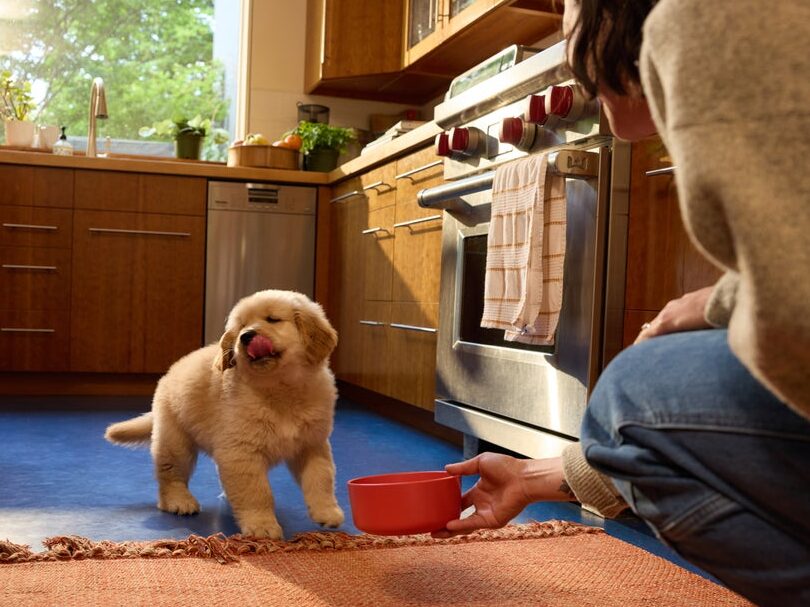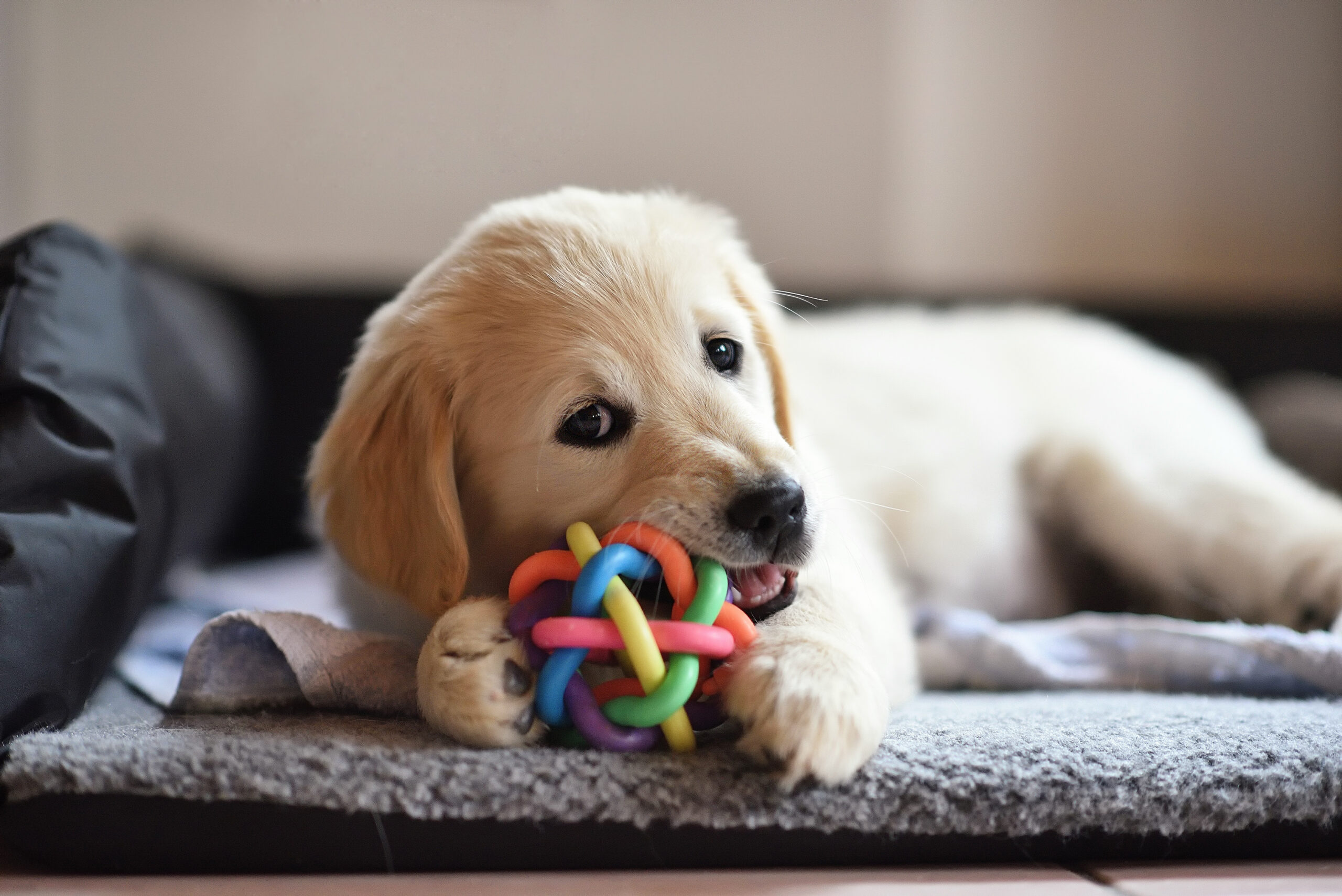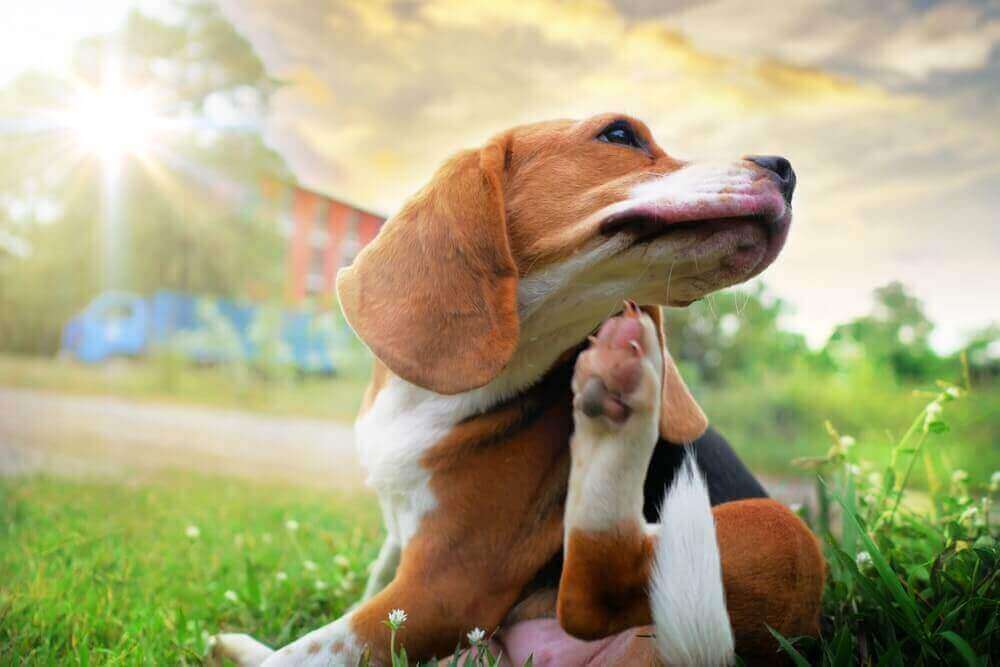Hey Ollie blog readers! We’re offering you an exclusive 60% OFF your starter box! Try now!
Your heart is ready for a new dog, but that’s not all you need to prepare! While it’s easy to say “Yes” to those endearing eyes and wagging tail, adding a dog to your life is an enormous responsibility that requires thoughtful planning and preparation, long before you bring them home.
If you’re ready for a new dog or puppy, ensure they receive the best possible start with our guide on how to prepare for a new dog and what supplies you’ll need to create a safe, happy, and dog-friendly home.
Preparing Your Home For A New Dog
Your home is your dog’s world. It’s where they will bond with you, learn good behavior, and have access to critical resources such as food, water, exercise, companionship, and a cozy bed. As the epicenter for your dog’s daily life, you’ll want to ready your home to be a safe, comfortable, and healthy place for your pup to thrive.
Dog Proofing Your Space
Dog proofing or puppy proofing is the first step to creating a safe environment for your new companion. Like childproofing, this process involves removing potential hazards from the dog’s indoor and outdoor environments to prevent serious injury or property damage. Successful puppy proofing involves recognizing harmful opportunities and items throughout the home and addressing them by removal, restricting access, or training.
Puppy proofing can be a big project, so plan ahead and give yourself plenty of time for key tasks such as:
- Identifying Hazards: Many common household and lawn items are toxic to dogs. Do your research to understand which ones may be hiding in your home or yard.
- Establishing Off-Limits Areas: Restrict your dog or puppy’s access to certain areas. This will make it easier to monitor their behavior, prevent bad habits (e.g., house soiling out of sight), and keep them away from known hazards.
- Cleaning and De-Cluttering: Thoroughly cleaning your puppy’s space(s) removes potential irritants like mold and dust and helps you uncover hidden hazards.
- Securing Toxic Substances, Foods, and Plants: While you don’t have to get rid of every hazardous item or ingredient, you should take action to keep them out of reach. This may include storing toxic foods in secure bins or containers, relocating toxic plants to inaccessible rooms, and moving toxic substances to high shelves or locked cabinets.
- Installing Gates, Fences, and Crates: Barriers define your dog or puppy’s space and separate them from potential hazards or threats. Have these items in place or check existing items for gaps or damage before bringing your dog home.
Dog or puppy proofing is a never-ending process. No matter how old your dog is or how well-trained they are, be on the lookout for potential dangers and be prepared to protect your pup.
Introducing Your Dog To Another Dog Or Cat
Introducing a new puppy to an older dog or cat requires patience and careful planning to ensure a smooth transition. The key is to manage their first interactions in a calm, controlled way, allowing them to adjust to each other’s scent and presence. Gradual, positive introductions help build trust and reduce stress for both pets.
- Provide Safe Spaces: Set up separate spaces for each pet, where they can see or smell but not make contact with one another. If this is too frightening, put up a barrier (e.g., a curtain or closed door) so the pets cannot see each other.
- Share a Blanket or Toy: Take an item from either pet and present it to the other in their safe space. Allow them to investigate the item and become familiar with the other pet’s scent.
- Begin Controlled Introductions: Keep your new puppy or dog on a leash during the first few introductions. If you are concerned, leash the other dog to prevent physical contact.
- Focus on Being Calm and Neutral: Use soothing tones and treats to reward good behavior. Avoid holding your breath or tightening the leash as these actions can trigger fights.
- Observe Both Pets for Stress: Monitor your pets’ body language and separate them if tensions rise. Take each pet to their safe space to rest, allowing them to regroup and try again later.
- Advocate for Each Pet: Don’t rush the process. Ensure each pet feels safe and comfortable during each interaction. Don’t let pets bully one another or play too rough.
If you are struggling to introduce your pets, schedule a consultation with a professional trainer.
Introducing Your New Dog To Kids
Introducing a new dog to children requires patience and supervision to ensure safety for both. Whether your dog is a puppy or a senior, it’s important to teach kids how to interact gently and respect the dog’s space. With clear boundaries, positive reinforcement, and time, kids and dogs can form a strong bond. Tips for a safe introduction include:
- Teach Calm Behavior: Instruct kids to let the dog approach them and avoid sudden movements.
- Maintain Constant Supervision: Monitor all interactions, especially when the dog is eating, sleeping, or playing with toys.
- Encourage Gentle Petting: Show kids how to pet the dog softly and avoid sensitive areas like the head or tail.
- Respect the Dog’s Boundaries: Teach kids to respect the dog’s signals, like walking away or seeking a quiet space.
- Practice Patience: Give both the dog and children time to adjust to each other.
Create a Safe Zone For Your Pup
Creating a comfortable, pet-friendly space in your home is essential for helping your new dog feel safe and settled. Whether this is a safe enclosure such as a playpen for your puppy or a cozy bed in a quiet corner for your adult dog, having a designated space helps your new friend feel secure right from the start.
- Setting Up a Safe Space: Select a place that is centrally located in your home so that your dog will always feel like part of the family. Ensure you puppy-proof the space before adding your dog’s essentials, such as food and water dishes, toys, and a bed. Make the space more inviting with fun chews or a Kong, or by feeding your dog in their safe space.
- Choosing the Right Bed: Pay attention to your dog’s sleeping habits—do they curl up, sprawl out, or prefer the floor over the couch? Do they chew or shred soft toys? Use these insights to choose a bed that fits their style and needs, whether it’s a cozy, cushioned bed or one made from durable, chew-resistant fabric.
Must-Have Dog or Puppy Supplies
Dogs’ needs are simple, until they need what you don’t have! Ensure you have all the essential supplies for a new dog before you bring them home so you can enjoy a smooth and successful start to your new life together. Let’s dive into our how to prepare for a new dog shopping list!
Food and Water Needs
This one’s obvious—or is it? Your pup’s hydration and nutrition are the foundation for their overall health. Serve up love—and wellness—with these top tips.
- Choose the Right Bowl: Look for dog bowls that are appropriately sized, easy to clean, and have a non-skid bottom. If your pup is a speed eater, consider a slow feeder bowl.
- Keep Them Hydrated: Provide fresh water at all times. Wash your dog’s bowls daily to prevent bacteria buildup.
- Select the Right Dog Food: With so many dog foods on the market, it can be challenging to know if you’re choosing the best for your pup. Ollie takes the guesswork out of your dog’s nutrition with tailored meal plans to suit every life stage and flavor preference. Plus, because every Ollie recipe is designed by a veterinary nutritionist, you can trust that your pup is receiving everything they need to support their overall health. Check out our quiz to see your customized recommendations!
Grooming Supplies
Proper grooming is essential for all dogs, especially those with long or curly hair or a thick double coat. Regular grooming helps maintain cleanliness, reduces shedding, prevents matting, and supports skin health. As a new dog owner, you’ll need to learn how to groom your dog at home or find a trusted groomer to maintain your dog’s coat. Recommended grooming supplies for a new dog include:
- Brushes and Combs: Choose a brush or comb suited for your dog’s coat. Dogs with thick or long coats typically need a pin brush, slicker brush, and a wide-toothed comb to keep their coat tangle-free and gently remove mats. Short-haired breeds require only a rubber curry brush or bristle brush to remove dead undercoat.
- Shampoo and Towels: A gentle dog-specific cleansing shampoo is appropriate for most dogs. However, your veterinarian may recommend a medicated option if your pup suffers from frequent skin irritation. Use absorbent towels made with microfiber to rapidly absorb water and help speed the drying process.
- Nail Clippers: Regular nail trimming prevents discomfort and injuries. Popular nail clippers include hand-held trimmers that cut across the nail and motorized grinders that sand the nail to the desired length.
- Bathtime Supplies: A non-slip mat and detachable shower head can help make bathing your dog easier and safer, especially for older dogs and wiggly puppies. Lickable treat mats, which can be attached to the bath or shower with suction cups, can help keep pups distracted.
If you’re unsure about grooming your dog at home, schedule a consultation with a local groomer and ask them to demonstrate basic tasks such as nail clipping, bathing, dematting, and proper brushing. This is a great way to learn and build rapport with a professional groomer. If your dog requires regular trimming or more complex techniques, interview several groomers to find the right fit for you and your pup.
Health and Safety Essentials
Life with a dog can be unpredictable! Staying prepared for minor injuries, accidents, and emergencies can help you care for your pup—and stay calm—in every circumstance. Must have health and safety supplies for a new dog include:
- First Aid Kit for Dogs: Having a well-stocked first aid kit for your four-legged friend allows you to manage minor ailments at home or until you can get your pup to the vet. Select a commercially available first aid kit for dogs or make your own. It’s also important to learn basic first aid for dogs so you can respond quickly when the unexpected happens.
- Flea and Tick Prevention: Parasites are more than a nuisance—they can transmit harmful diseases, cause intense irritation, and infest your home. Year-round veterinarian-prescribed flea and tick prevention is the best way to protect your pet and your family.
- Identification Tags and Microchips: One in three pets goes missing in their lifetime. Proper identification, including updated tags and a registered microchip, is the best way to ensure your pup’s safe return.
Walking and Exercise Equipment
Walking does wonders for your dog’s physical and mental health—and yours, too! Keep your pup’s paws pounding the pavement—and their body and mind at peak wellness, with properly fitted, comfortable, and safe gear, such as:
- Leashes and collars: Whether your dog’s collar is nylon, leather, fashion-forward or purely functional, it should fit well to prevent escape. Leashes should provide a safe latching mechanism and allow you to maintain a solid, yet comfortable grip. Other leash considerations include:
- Size: Lightweight leashes are ideal for small dogs and typically feature smaller hardware. Thicker, heavyweight leashes are appropriate for large or strong dogs and those who pull.
- Length: Short leashes will help you keep your pup close, while long lines (e.g., 10 feet and longer) can provide them with freedom to romp and explore in areas where it is permitted.
- Style: Traditional fixed-length leashes offer better control and help keep your dog close during walks. Retractable leashes can lead to injuries and accidents, such as getting tangled, running into traffic, or encountering aggressive dogs.
- Harnesses: Harnesses are ideal for brachycephalic (i.e., flat-faced) dogs, dogs with airway conditions, and those who may escape a traditional collar. Look for a harness that provides a comfortable range of motion for the front legs.
- Accessories: Show off your responsible dog owner skills by carrying doggy bags to pick up your dog’s messes and bite-sized treats to reward good behavior!
Toys for Physical and Mental Stimulation
Play is critical for your dog’s physical and mental well-being. Toys are a great way to engage your dog and provide exercise and stimulation to promote overall health and prevent boredom and destructive behavior. Offering various toys can help you determine your pup’s favorites and keep them interested.
- Chew Toys: Chew toys help satisfy your dog’s natural urge to chew while promoting dental health. Look for toys made with durable rubber or other materials that flex under pressure to prevent injuries to your dog’s teeth or gums.
- Interactive Toys: Puzzle or treat-dispensing toys challenge dogs to think critically and use natural behaviors to receive rewards.
- Fetch Toys: Balls, decoys, and frisbees encourage running and retreiving. Fetch is a great way to encourage motion and strengthen the dog-owner bond.
Play smart! Monitor your dog’s behavior and routinely check toys for wear and tear.
Basic Dog Training Tools and Supplies
A well-trained dog begins with the right tools and techniques. Positive reinforcement dog training makes learning more effective and enjoyable for you and your dog, leading to a stronger relationship and the canine companion of your dreams. Get set for training with helpful tools such as:
- Training Treats: Small, tasty rewards motivate your dog and reinforce good behavior.
- Clickers: Clickers are simple handheld noisemakers that help mark the exact moment your dog performs the right behavior, improving clarity and timing.
- Training Pads: Training pads can help puppies learn where to go during potty training and give adult dogs a place to eliminate when they can’t go outside.
Travel and Transport
Dogs make incredible travel companions, but it’s up to pet parents to ensure every trip is smooth, safe, and stress-free.
Safe Car Travel with Dogs
Preparation should begin with training and socialization to help your pup be calm and confident in new situations and environments, including your vehicle. Key aspects of being road trip ready include:
- Selecting a Dog Seat Belt or Carrier: Unrestrained dogs can cause distracted driving or be injured during a sudden stop or accident. Always ensure your pup rides in safety and comfort with a dog seat belt, crate, or carrier.
- Planning Road Trips With Your Dog In Mind: Ensure to book pet-friendly accommodations and plan regular potty breaks every two to three hours when you’re on the road. Pack essentials such as food, water, bowls, toys, and any necessary medications. Try to stick to your dog’s usual eating and exercise routine to minimize stress and digestive upset.
On-The-Go Supplies
Dogs are always up for an adventure and their zest for life makes us equally adventurous, too. Be prepared to seize the day with on-the-go supplies for a new dog that keep them safe, comfortable, and ready for fun, such as:
- Dog Carriers and Portable Crates: Dog carriers provide safe confinement in your vehicle while a lightweight portable crate creates a home away from home anywhere you go.
- Portable Water Bottles: Hydration helps dogs stay cool, alert, and strong. Offer your dog fresh water regularly, especially during warm weather.
- Travel Bowls: Collapsible silicone dog bowls are a convenient, packable way to provide your dog with food and water, practically anywhere!
On the surface, learning how to prepare for a new dog can seem easy, but sharing your life with a canine companion is a big commitment. Taking the time to prepare your home, vehicle, and daily routine for a new dog or puppy ensures you can provide them not only with endless love, but also safety, comfort, happiness, and health.
The Ollie blog is devoted to helping pet parents lead healthier lives with their pups. If you want to learn more about our fresh, human-grade food, check out MyOllie.com.
Tagged As:

The nutrition your dog needs,
the food they want.

Enjoying our articles? Subscribe our Newsletters and get new articles directly to your inbox
You might also like
13 May 2025
8 MINS READ
Puppy Training Guide & Behavior Timeline
Bringing home a puppy is pure magic. It’s also pure chaos—tiny teeth, zoomies, accidents in the house, and moments that make you wonder if you’re raising a future genius or a tiny tornado. …
by Ollie Pets
10 May 2025
12 MINS READ
New Puppy Checklist: Guide To Prepare For A New Dog
Bringing home a new puppy? This checklist covers everything new dog owners need—from essential supplies to training, feeding, and first vet visits.
by Ollie Pets
3 April 2025
9 MINS READ
Home Remedies for Fleas on Dogs: 10 Natural Ways That Actually Work
Wondering what kills fleas on dogs instantly and naturally? If your pup is scratching like crazy, it may be time to take action. In this guide, we’ll show you the most effective home remedies for…







